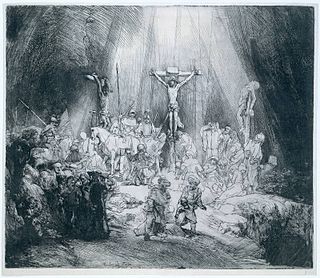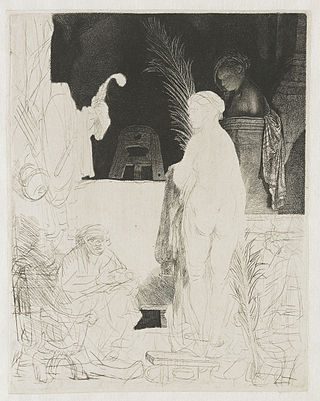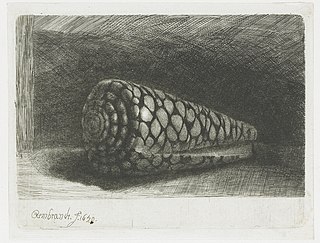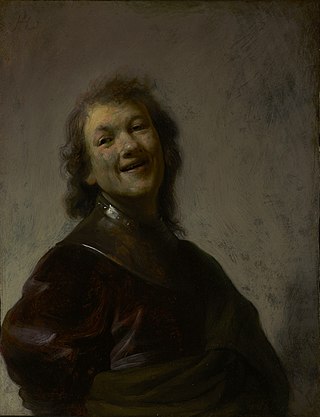
Sir Francis Seymour Haden PPRE, was an English surgeon, better known as an original etcher who championed original printmaking. He was at the heart of the Etching Revival in Britain, and one of the founders of the Society of Painter-Etchers, now the Royal Society of Painter-Printmakers, as its first president. He was also a collector and scholar of Rembrandt's prints.

The Rembrandt House Museum is a museum located in a former house in the Jodenbreestraat, in the center of Amsterdam. Between 1639 and 1658, the house was occupied by the well-known Dutch painter Rembrandt van Rijn, who also had his studio and art dealership there.

Rembrandt Harmenszoon van Rijn, usually simply known as Rembrandt, was a Dutch Golden Age painter, printmaker, and draughtsman. An innovative and prolific master in three media, he is generally considered one of the greatest visual artists in the history of art. It is estimated Rembrandt produced a total of about three hundred paintings, three hundred etchings, and two thousand drawings.

The Virgin and Child with a Cat is an etching made in 1654 by the Dutch artist Rembrandt van Rijn (1606–1669). The Victoria and Albert Museum has in its collection one of the earliest impressions of this etching and the actual copper plate from which the image is taken.

The Hundred Guilder Print is an etching by Rembrandt. The etching's popular name derives from the large sum of money supposedly once paid for an example. It is also called Christ healing the sick, Christ with the Sick around Him, Receiving Little Children, or Christ preaching, since the print depicts multiple events from Matthew 19 in the New Testament, including Christ healing the sick, debating with scholars and calling on children to come to him. The rich young man mentioned in the chapter is leaving through the gateway on the right.

The Return of the Prodigal Son is an oil painting by Rembrandt, part of the collection of the Hermitage Museum in St. Petersburg. It is among the Dutch master's final works, likely completed within two years of his death in 1669. Depicting the moment of the prodigal son's return to his father in the Biblical parable, it is a renowned work described by art historian Kenneth Clark as "a picture which those who have seen the original in St. Petersburg may be forgiven for claiming as the greatest picture ever painted".

Joseph and Potiphar's Wife is a 1634 etching by Rembrandt. It depicts a story from the Bible, wherein Potiphar's Wife attempts to seduce Joseph. It is signed and dated "Rembrandt f. 1634", and exists in two states.

The dozens of self-portraits by Rembrandt were an important part of his oeuvre. Rembrandt created approaching one hundred self-portraits including over forty paintings, thirty-one etchings and about seven drawings; some remain uncertain as to the identity of either the subject or the artist, or the definition of a portrait.

The Raising of Lazarus is an oil-on-panel painting by the Dutch artist Rembrandt from early in his career; it was probably painted between 1630 and 1632. The work depicts the Raising of Lazarus as told in the Gospel of John, Chapter 11. It is in the collection of the Los Angeles County Museum of Art.

The Three Crosses is a 1653 print in etching and drypoint by the Dutch artist Rembrandt van Rijn, which depicts the crucifixion of Jesus Christ. Most of his prints are mainly in etching and this one is a drypoint with burin adjustments from the third state onwards. It is considered "one of the most dynamic prints ever made".

Self-Portrait at the Age of 34 is a self-portrait by Rembrandt, dating to 1640 and now in the National Gallery in London. The painting is one of many self-portraits by Rembrandt, in both painting and etching, to show the artist in a fancy costume from the previous century. In this case specific influences in the pose have long been recognised from Raphael's Portrait of Baldassare Castiglione and Titian's A Man with a Quilted Sleeve in the National Gallery. Rembrandt saw both of these in Amsterdam, in his day the centre of Europe's art trade, and made a sketch of the Raphael, with its price.

The Goldweigher's Field is a 1651 etching by Rembrandt now held by many museums, including the British Museum, the Rijksmuseum, and the Metropolitan Museum of Art. It is based on a landscape drawing in the collection of the Museum Boijmans van Beuningen.
Gary Schwartz is an American-born Dutch art historian, who is a scholar of Rembrandt and art of the Dutch Golden Age.

Descent from the Cross by Torchlight is a print by Rembrandt in etching and drypoint, produced in 1652. Only one state of the work is known, with copies in major collections including the Rijksmuseum, British Museum, and Rembranthuis. It is signed and dated at the bottom right. It was assigned the number B. 83 by Adam von Bartsch. Some late impressions of the work are on Japanese paper, which Rembrandt used more and more from 1650 onwards. The depiction of the shadows on the plate was modified after the artist's death.

The Artist and his Model is a print by Rembrandt, known in two states, both incomplete. Copies of the work are in the British Museum, the Rijksmuseum, the Mikkel Museum, the Saint Louis Art Museum and many other collections. It was numbered B. 1921 by.

Portrait of Jan Six is a 1647 etching by Rembrandt, known in five states. It shows Jan Six, also the subject of a painted portrait by the same artist.

The State Bed is a 1646 print by Rembrandt in etching and drypoint. It is also known as Le Lit à la française, a title first given to it in Edme-François Gersaint's 1751 Catalogue raisonné de toutes les pièces qui forment l’œuvre de Rembrandt.

The Three Trees is a 1643 print in etching and drypoint by Rembrandt, his largest landscape print. It was assigned the number B.212 by Adam von Bartsch and impressions of the work are in the Rijksmuseum, the Musée des beaux-arts du Canada and the Bibliothèque nationale de France.

The Shell, also known as Rembrandt's Shell or Conus Marmoreus, or in Dutch as De schelp or Het schelpje, is a 1650 drypoint and etching by Rembrandt van Rijn. Catalogued as B.159, it is Rembrandt's only still life etching. Only a handful of original prints are known, in three states.

Rembrandt Laughing is a c. 1628 oil on copper painting by the Dutch painter Rembrandt van Rijn. It is an elaborate study of a laughing face, a tronie, and, since it represents the painter himself, one of over 40 self-portraits by Rembrandt, probably the earliest elaborate one. The painting, which was only recently discovered, is now in the J. Paul Getty Museum, California.



















